Drip Irrigation
What a beautiful day we had yesterday! Knowing that vineyard work was soon to begin, we have been doing concentrated schoolwork in preparation to take time off. With the temperature near 70F, we decided to enjoy the warmth. We began laying the drip irrigation tape for this year’s planting. We will be adding 2 1/3 acres of grapes in March, 2 acres will be Petit Verdot and 1/3 acre will be Muscat Canelli. Our rows are 1/3 of a mile long and 3 rows equals one acre, so we will be adding 7 more rows.
What made this year’s expansion even more exciting for us was the fact that we are using our own tractor! John had tried to arrange to use a neighbor’s big John Deere = speed and GPS accuracy. Since our ’54 Ford tractor is not equipped with a GPS system, the rows were first marked off at the 8 foot spacing. (This tractor was generously gifted to us by a friend who got out of farming.) The dry, hard ground was then ripped to a depth of about a foot (broken up with a blade) to make it easier for the tape to go in the ground. The vine rows are 8 feet apart and drip tape will be laid down the center of the rows. The picture below shows the ripped lines where the drip tape will be. The rye stubble protected our land from blowing away in the wind storms. The small green plants are the self-seeded rye that will provide the next year’s protection.
As with most things, getting the tractor set up right seems to be the most time consuming part. The taping rig, courtesy of our grape consultant, is essentially a blade that cuts into the dirt and allows the irrigation tape to be placed at an even depth in the ground. It is first attached to the tractor, then the depth of the plow can be set and finally the roll of tape put in place. The irrigation tape will spin off the roll in the arms above head clearance and feed down through a tube at the back of the knife blade into the ground.
At the start of a new row, the tape must be held in place by a lucky volunteer until the tractor is far enough ahead so that the weight of the dirt prevents it from being pulled out by the tractor.
I know our tractor is old, but I really do not think it needs to be pushed along! Then again, a little help never hurt anyone 🙂
Normally, someone sits in the seat or walks beside the rig to prevent the tape from twisting. (Did they put sunblock on?)
At the end of the row, the tape is cut. These cut ends will be connected later to the vineyard irrigation system.
The tape at this point is flat with emitters, or holes, every 2 feet. When it is all hooked up, water will fill the tape and evenly come out the holes for the grapevines. Each of these holes drip at ~0.24 gal/hr. Every now and then, a gopher will make an extra hole in the tape, but their holes leak quite a bit faster!
Once all the rows are finished, the boys will go back over each one with the tractor packing the dirt down. Gophers are very prevalent here in west Texas and they love to dig in fresh dirt. Packing the dirt down will hopefully keep them from digging and chewing through the drip tape.

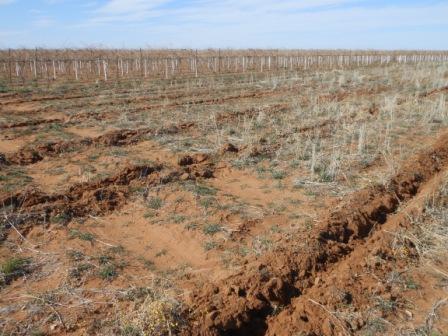
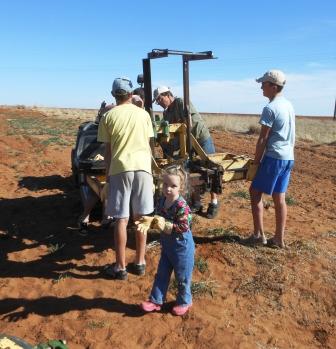
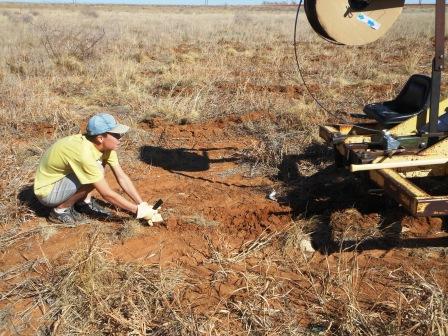
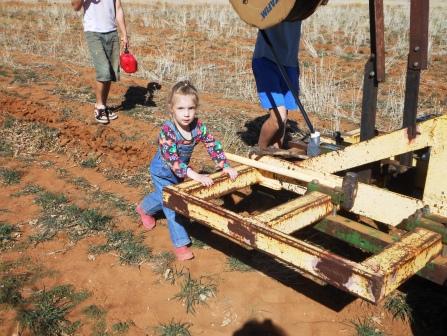
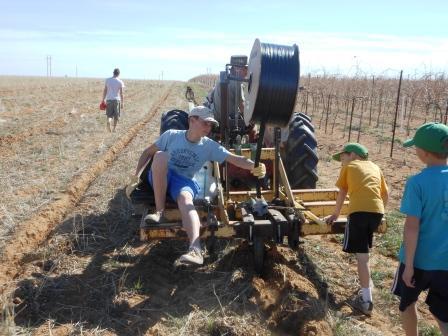

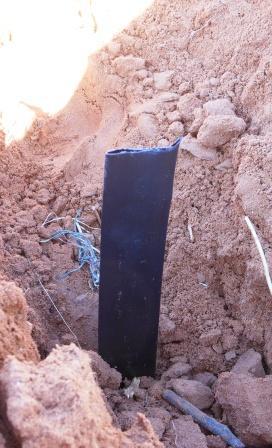
One Comment